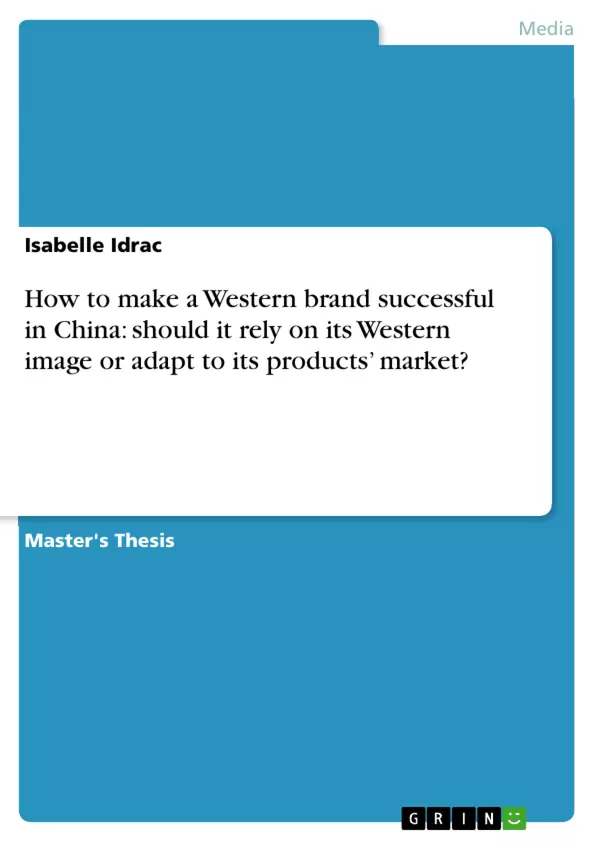The Chinese market has become very attractive for Western companies. It is a huge consumption market with more than 1, 3 billion inhabitants and it is at the same time a goods’ provider with a very low labor cost. Western companies can nowadays be very successful in China because the population knew lately huge changes. Chinese people purchasing power is rising and they can afford goods that they could not reach before because it was too expensive or not available. The development of a rich elite and a large middle class has been accompanied by a rising strong taste for Western image, particularly in the luxury field.
But the Chinese market is still quite different than Western ones. The Chinese culture is totally divergent than in the West and the economy doesn’t work the same way and that impact on the Chinese consumers’ profile. Besides, there are huge inequalities in China since the whole country doesn’t evolve in a homogeneous way.
To be successful on this market for a Western brand, it is necessary to develop a marketing strategy adapted to the Chinese consumers’ expectations according to the products’ activity segments.
In the present thesis, we study which marketing strategy a Western brand should follow to be successful on the Chinese market according to its activity segment. Indeed, we assume that a mass market brand should rather follow a Chinese consumer’s adapted strategy and that a luxury brand should keep the same Western strategy in China.
Table of Contents
- Abstract
- Introduction
- The Chinese Market
- Economic factors
- Cultural factors
- Chinese consumer's profile and segmentation
- Marketing Strategy and Findings in the Literature
- The Marketing-Mix Strategy
- Success of Western Mass Market Brands and Luxury in China
- Mass Market Brands
- Luxury Brands
- Case Studies
- Apple
- Nestlé
- Chanel
- Gucci
- Conclusion
Objectives and Key Themes
This thesis explores the success factors for Western brands in the Chinese market, specifically analyzing whether brands should rely on their Western image or adapt their products to the local market. The main objective is to understand the optimal marketing strategy for Western companies based on their activity segment – mass market or luxury. Key themes explored include:- The evolving Chinese consumer market and its unique characteristics
- The impact of economic and cultural factors on consumer behavior
- Effective marketing strategies for different product segments
- The role of brand adaptation and localization in market penetration
- Comparative case studies of successful Western brands in China
Chapter Summaries
- The introduction examines the attractiveness of the Chinese market for Western companies, highlighting the growth of consumer purchasing power and the increasing preference for Western products, particularly in luxury goods. It also acknowledges the cultural and economic differences between China and Western markets, emphasizing the importance of a customized marketing strategy for success.
- The first part of the thesis delves into the reasons for Western brands' success in China, exploring both economic and cultural factors. It analyzes the evolving Chinese consumer profile and the key factors driving their buying decisions, including product convenience, quality, status, emotional factors, and brand consciousness.
- The second part delves into marketing strategies and findings from literature. It provides a general overview of the marketing-mix strategy for the Chinese market, discussing the four Ps (product, price, place, promotion) and highlighting the crucial role of brand naming in adapting to the local market. The chapter also explores the success of Western brands in both the mass market and luxury sectors, providing insights into strategies employed and challenges faced.
- The thesis then presents case studies of successful Western companies in China, examining the strategies of Apple, Nestlé, Chanel, and Gucci. These examples illustrate how different brands within the same activity segment can adopt diverse marketing approaches to achieve success.
Keywords
This thesis focuses on the intersection of marketing strategy and brand adaptation in the context of the Chinese market. Key areas of exploration include the Chinese market, Western brands, marketing-mix strategy, brand name adaptation, mass market, and luxury market. The study emphasizes the need for a nuanced understanding of the Chinese consumer, their unique needs and preferences, and the tailoring of strategies to achieve market penetration and brand success.- Citation du texte
- Isabelle Idrac (Auteur), 2013, How to make a Western brand successful in China: should it rely on its Western image or adapt to its products’ market?, Munich, GRIN Verlag, https://www.grin.com/document/231771



